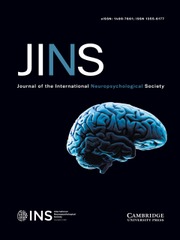Crossref Citations
This article has been cited by the following publications. This list is generated based on data provided by
Crossref.
Zammit, Andrea R.
Hall, Charles B.
Katz, Mindy J.
Muniz-Terrera, Graciela
Ezzati, Ali
Bennett, David A.
and
Lipton, Richard B.
2018.
Class-Specific Incidence of All-Cause Dementia and Alzheimer’s Disease: A Latent Class Approach.
Journal of Alzheimer's Disease,
Vol. 66,
Issue. 1,
p.
347.
Edmonds, Emily C.
Weigand, Alexandra J.
Thomas, Kelsey R.
Eppig, Joel
Delano-Wood, Lisa
Galasko, Douglas R.
Salmon, David P.
and
Bondi, Mark W.
2018.
Increasing Inaccuracy of Self-Reported Subjective Cognitive Complaints Over 24 Months in Empirically Derived Subtypes of Mild Cognitive Impairment.
Journal of the International Neuropsychological Society,
Vol. 24,
Issue. 8,
p.
842.
Hanfelt, John J.
Peng, Limin
Goldstein, Felicia C.
and
Lah, James J.
2018.
Latent classes of mild cognitive impairment are associated with clinical outcomes and neuropathology: Analysis of data from the National Alzheimer's Coordinating Center.
Neurobiology of Disease,
Vol. 117,
Issue. ,
p.
62.
Thomas, Kelsey R.
Eppig, Joel S.
Weigand, Alexandra J.
Edmonds, Emily C.
Wong, Christina G.
Jak, Amy J.
Delano‐Wood, Lisa
Galasko, Douglas R.
Salmon, David P.
Edland, Steven D.
and
Bondi, Mark W.
2019.
Artificially low mild cognitive impairment to normal reversion rate in the Alzheimer's Disease Neuroimaging Initiative.
Alzheimer's & Dementia,
Vol. 15,
Issue. 4,
p.
561.
Jammal, Alessandro A.
Ogata, Nara G.
Daga, Fábio B.
Abe, Ricardo Y.
Costa, Vital P.
and
Medeiros, Felipe A.
2019.
What Is the Amount of Visual Field Loss Associated With Disability in Glaucoma?.
American Journal of Ophthalmology,
Vol. 197,
Issue. ,
p.
45.
Veitch, Dallas P.
Weiner, Michael W.
Aisen, Paul S.
Beckett, Laurel A.
Cairns, Nigel J.
Green, Robert C.
Harvey, Danielle
Jack, Clifford R.
Jagust, William
Morris, John C.
Petersen, Ronald C.
Saykin, Andrew J.
Shaw, Leslie M.
Toga, Arthur W.
and
Trojanowski, John Q.
2019.
Understanding disease progression and improving Alzheimer's disease clinical trials: Recent highlights from the Alzheimer's Disease Neuroimaging Initiative.
Alzheimer's & Dementia,
Vol. 15,
Issue. 1,
p.
106.
Thomas, Kelsey R.
Edmonds, Emily C.
Eppig, Joel S.
Wong, Christina G.
Weigand, Alexandra J.
Bangen, Katherine J.
Jak, Amy J.
Delano‐Wood, Lisa
Galasko, Douglas R.
Salmon, David P.
Edland, Steven D.
and
Bondi, Mark W.
2019.
MCI‐to‐normal reversion using neuropsychological criteria in the Alzheimer's Disease Neuroimaging Initiative.
Alzheimer's & Dementia,
Vol. 15,
Issue. 10,
p.
1322.
Edmonds, Emily C.
McDonald, Carrie R.
Marshall, Anisa
Thomas, Kelsey R.
Eppig, Joel
Weigand, Alexandra J.
Delano‐Wood, Lisa
Galasko, Douglas R.
Salmon, David P.
and
Bondi, Mark W.
2019.
Early versus late MCI: Improved MCI staging using a neuropsychological approach.
Alzheimer's & Dementia,
Vol. 15,
Issue. 5,
p.
699.
Donders, Jacobus
2020.
The incremental value of neuropsychological assessment: A critical review.
The Clinical Neuropsychologist,
Vol. 34,
Issue. 1,
p.
56.
Larsen, Alexandra
Kolpacoff, Viktoria
McCormack, Kara
Seewaldt, Victoria
and
Hyslop, Terry
2020.
Using Latent Class Modeling to Jointly Characterize Economic Stress and Multipollutant Exposure.
Cancer Epidemiology, Biomarkers & Prevention,
Vol. 29,
Issue. 10,
p.
1940.
Asken, Breton M.
Thomas, Kelsey R.
Lee, Athene
Davis, Jennifer D.
Malloy, Paul F.
and
Salloway, Stephen P.
2020.
Discrepancy-Based Evidence for Loss of Thinking Abilities (DELTA): Development and Validation of a Novel Approach to Identifying Cognitive Changes.
Journal of the International Neuropsychological Society,
Vol. 26,
Issue. 5,
p.
464.
Ezzati, Ali
Zammit, Andrea R.
Habeck, Christian
Hall, Charles B.
and
Lipton, Richard B.
2020.
Detecting biological heterogeneity patterns in ADNI amnestic mild cognitive impairment based on volumetric MRI.
Brain Imaging and Behavior,
Vol. 14,
Issue. 5,
p.
1792.
Derrig, Hannah
Lavrencic, Louise M.
Broe, Gerald A.
Draper, Brian
Cumming, Robert G
Garvey, Gail
Hill, Thi Yen
Daylight, Gail
Chalkley, Simon
Mack, Holly
Lasschuit, Danielle
Delbaere, Kim
and
Radford, Kylie
2020.
Mild cognitive impairment in Aboriginal Australians.
Alzheimer's & Dementia: Translational Research & Clinical Interventions,
Vol. 6,
Issue. 1,
Göthlin, Mattias
Eckerström, Marie
Lindwall, Magnus
Rolstad, Sindre
Eckerström, Carl
Jonsson, Michael
Kettunen, Petronella
Svensson, Johan
and
Wallin, Anders
2020.
Latent Cognitive Profiles Differ Between Incipient Alzheimer’s Disease and Dementia with Subcortical Vascular Lesions in a Memory Clinic Population.
Journal of Alzheimer's Disease,
Vol. 73,
Issue. 3,
p.
955.
Zammit, Andrea R.
Bennett, David A.
Hall, Charles B.
Lipton, Richard B.
Katz, Mindy J.
and
Muniz-Terrera, Graciela
2020.
A Latent Transition Analysis Model to Assess Change in Cognitive States over Three Occasions: Results from the Rush Memory and Aging Project.
Journal of Alzheimer's Disease,
Vol. 73,
Issue. 3,
p.
1063.
Edmonds, Emily C.
Weigand, Alexandra J.
Hatton, Sean N.
Marshall, Anisa J.
Thomas, Kelsey R.
Ayala, Daniela A.
Bondi, Mark W.
and
McDonald, Carrie R.
2020.
Patterns of longitudinal cortical atrophy over 3 years in empirically derived MCI subtypes.
Neurology,
Vol. 94,
Issue. 24,
MacAulay, Rebecca K
Halpin, Amy
Cohen, Alex S
Calamia, Matthew
Boeve, Angelica
Zhang, Le
Brouillette, Robert M
Foil, Heather C
Bruce-Keller, Annadora
and
Keller, Jeffrey N
2020.
Predictors of Heterogeneity in Cognitive Function: APOE-e4, Sex, Education, Depression, and Vascular Risk.
Archives of Clinical Neuropsychology,
Vol. 35,
Issue. 6,
p.
660.
Anusha, A.S.
Ranjan, Uma
Sharma, Medha
and
Dutt, Siddharth
2020.
Identification of Patterns of Cognitive Impairment for Early Detection of Dementia.
p.
5498.
Alashwal, Hany
Diallo, Thierno M. O.
Tindle, Richard
and
Moustafa, Ahmed A.
2020.
Latent Class and Transition Analysis of Alzheimer's Disease Data.
Frontiers in Computer Science,
Vol. 2,
Issue. ,
Sible, Isabel J.
Nation, Daniel A.
and
Wharton, Whitney
2020.
Long-Term Blood Pressure Variability Across the Clinical and Biomarker Spectrum of Alzheimer’s Disease.
Journal of Alzheimer's Disease,
Vol. 77,
Issue. 4,
p.
1655.


